|
Messerschmitt Bf 109 F-4
Weekend Edition
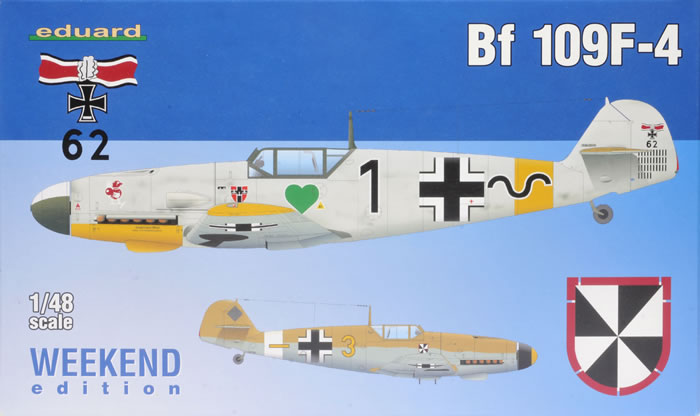
Eduard ProfiPACK, 1/48 scale
S
u m m a r y |
| Catalogue Number: |
Eduard Kit No. 84146 - Messerschmitt Bf 109 F-4 Weekend Edition |
| Scale: |
1/48 |
| Contents and Media: |
185 parts in grey coloured plastic (including 89 marked not for use); six parts in clear; markings for two aircraft |
| Price: |
USD$29.95 plus shipping
available online now from Eduard
USD$31.99 plus shipping available online from Squadron
GBP£25.99 (£21.66 Export Price) plus shipping available from Hannants |
| Review Type: |
FirstLook |
| Advantages: |
Accurate; high level of detail; outstanding surface features including crisply recessed panels and subtle rivet lines where appropriate; separate control surfaces; useful options including bomb racks and trop filter (although many options not applicable for this kit); high quality decals. |
| Disadvantages: |
|
| Conclusion: |
Eduard's 1/48 scale Bf 109 F-4 is a welcome addition to their Weekend Edition range, representing exceptional value at less than USD$30. Highly Recommended. |
Reviewed by Brett Green

Eduard's 1/48 scale Messerschmitt Bf 109 F cockpit
is available online from Squadron.com for only $23.99!
The Messerschmitt Bf 109 F delivered a major transformation to the famous Augsburg Eagle. The airframe was streamlined with a newly designed engine cowling, large spinner, rounded wing tips, revised flaps and many mechanical modifications compared to the earlier Bf 109 E.
The Bf 109 F entered service in 1941 at around the same time as the RAF introduced the Spitfire Mk.V. RAF Fighter Command also switched to offensive operations over France and Belgium during this period, creating a new challenge for the Luftwaffe.

The new Spitfire was superior to the Bf 109 F in most respects, and it would not be until early 1942 with the general introduction of the Focke-Wulf Fw 190 that a Luftwaffe fighter aircraft would gain a temporary upper hand over the English Channel.
Despite this see-sawing combat on the Channel Front, the Messerschmitt Bf 109 F achieved stunning success over the grassy steppes and frozen tundras of Russia, and the harsh desert of North Africa during 1941 and 1942.
Eduard has a tradition of releasing "Weekend Edition" versions of established kits that omit photo-etched parts and masks, and are available at a lower price. Eduard launched their 1/48 scale Erla Bf 109 F-4 ProfiPACK last year with all the goodies, and now its budget counterpart is available.
Eduard's Bf 109 F-4 Weekend Edition comprises 185 parts in grey plastic, six parts in clear and markings for two aircraft. 89 of the parts are marked “not for use” this time around, and there are a few optional parts too, so the actual number of parts used is quite modest.
As far as I can tell, the plastic parts in this kit are identical to those in the recent Bf 109 F-4 ProfiPACK kit. This is a good thing!
Eduard supplies the instrument panel as a plastic part with an optional decal overlay plus decals for the harness straps. The radiator faces are plastic parts too.
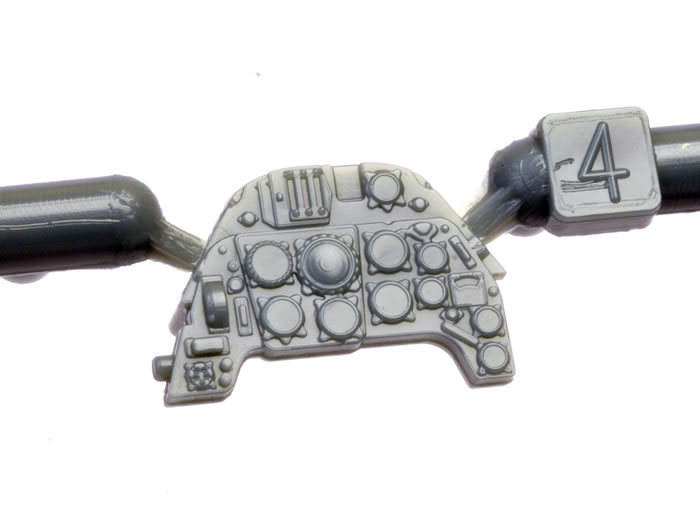
In 2013, Eduard’s Spitfire family set a new benchmark for 1/48 scale surface detail, and their Bf 109 F-4 kits are equally impressive in this regard. Panel lines are very crisp, fine and even. Lines of rivets are present, but they are incredibly subtle. The rivet lines seem to accurately follow the pattern applied to the full-sized aircraft too.
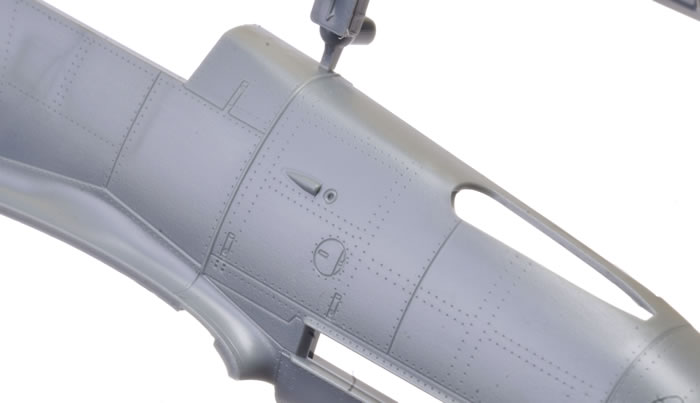
The canopy is offered in three parts so that the centre section may be posed open if desired. The cockpit fuel line is also supplied as a clear part - a nice touch.
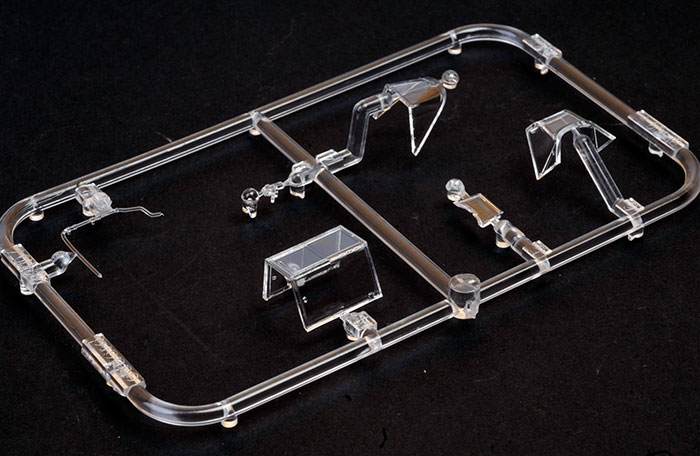
I was impressed to see that the small scoops on the nose are actually hollowed out - nice! Other raised surface features include the sealing strip between the mid-fuselage and the rear of the engine cowling.
Fabric matches this high standard, with strip and stitching texture beautifully presented on the control surfaces. If you look closely enough, you will even see the zig-zag pinking edges on the fabric strips.
The inclusion of the clear fuel line is a nice touch . The inspection tube may be masked so that it remains clear after painting.
The exhausts are supplied in one piece for each side. The centreline weld beads are present, and each of the stacks are hollowed out at the end.
Propeller blades look to be a good shape, with nice pitch collar and hub detail. Two other styles are included. These are for the Bf 109 G versions.
Markings
Markings are supplied for two interesting Bf 109 F-4s. To quote the marking instructions:
- Bf 109 F-4/Z W. Nr. 13125 flown by Oblt. M. – H. Ostermann, CO of 8./JG 54, Siverskaya, Soviet Union, Beginning of May 1942
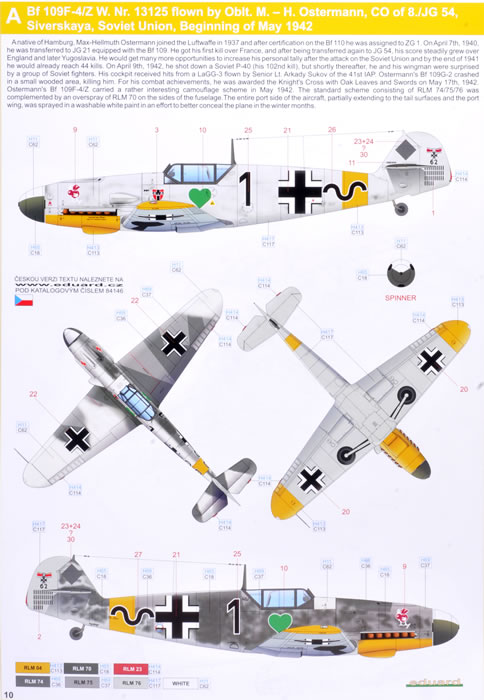
"A native of Hamburg, Max-Hellmuth Ostermann joined the Luftwaffe in 1937 and after certification on the Bf 110 he was assigned to ZG 1. On April 7th, 1940, he was transferred to JG 21 equipped with the Bf 109. He got his first kill over France, and after being transferred again to JG 54, his score steadily grew over England and later Yugoslavia. He would get many more opportunities to increase his personal tally after the attack on the Soviet Union and by the end of 1941 he would already reach 44 kills. On April 9th, 1942, he shot down a Soviet P-40 (his 102nd kill), but shortly thereafter, he and his wingman were surprised by a group of Soviet fighters. His cockpit received hits from a LaGG-3 flown by Senior Lt. Arkady Sukov of the 41st IAP. Ostermann's Bf 109G-2 crashed in a small wooded area, killing him. For his combat achievements, he was awarded the Knight's Cross with Oak Leaves and Swords on May 17th, 1942. Ostermann's Bf 109F-4/Z carried a rather interesting camouflage scheme in May 1942. The standard scheme consisting of RLM 74/75/76 was complemented by an overspray of RLM 70 on the sides of the fuselage.The entire port side of the aircraft, partially extending to the tail surfaces and the port wing, was sprayed in a washable white paint in an effort to better conceal the plane in the winter months."
- Bf 109F-4/Z/trop flown by Uffz. F. Schweiger, 6./JG 3, San Pietro, Italy, February 1942
"Franz Schweiger, a native of Ulm, was attached to II./JG 3 after completion of pilot training in the summer of 1941. He took part in the ongoing invasion of the Soviet Union and began to regularly record successes over enemy fighters from August on. From January to April 1942, II. Gruppe served in North Africa, but further success by Schweiger would have to wait until his return to the Eastern Front. On March 9th, 1944, he was named CO of 1./JG 3 by which time the entire Geschwader fought within the framework of the Defence of the Reich combating Allied bombing raids. On April 24th, 1944, Lt. Schweiger got his 67th kill, a P-51 Mustang. Due to problem with fuel supply, he decided to return to base and he was shot down near Augsburg. He managed to belly in, but was killed by an American fighter while exiting his aircraft. On October 23rd, 1942, he was awarded the Knight's Cross for his achievements. Luftwaffe aircraft operating over North Africa were painted RLM 79 Sandgelb on the upper and side surfaces, with RLM 78 Himmelblau lower surfaces. The engine cowl bore the name of the pilot's girlfriend."
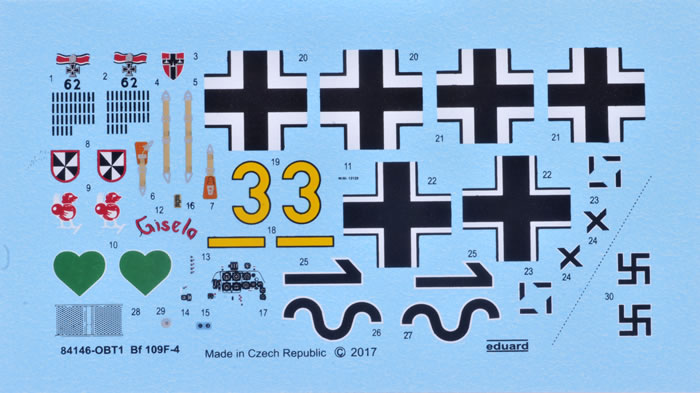
The two decal sheets have been perfectly printed in the Czech Republic. One sheet carries the national markings and unique numbers, unit insignia and victory markings; while the other has a wide selection of generic stencil markings that will be suitable for mid-war subjects.
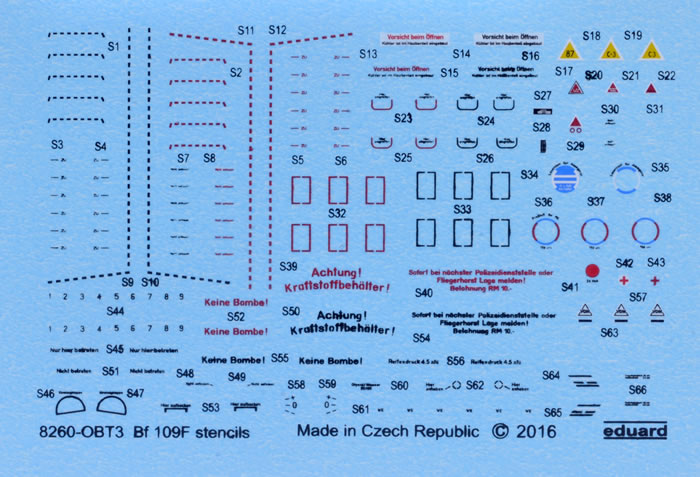
Printing, colours and registration is perfect on my sample.
Eduard's 1/48 scale Bf 109 F-4 is a welcome addition to their Weekend Edition range, representing exceptional value at less than USD$30.00.
These stripped down versions are also ideal bases for further detail, such as the Eduard BRASSIN Bf 109 F-4 cockpit.
Highly Recommended.
Thanks to Eduard for the sample
Review Text Copyright © 2017 by
Brett Green
Page Created 11 September, 2017
Last updated
12 September, 2017
Back to HyperScale Main Page
Back to Reviews Page |
